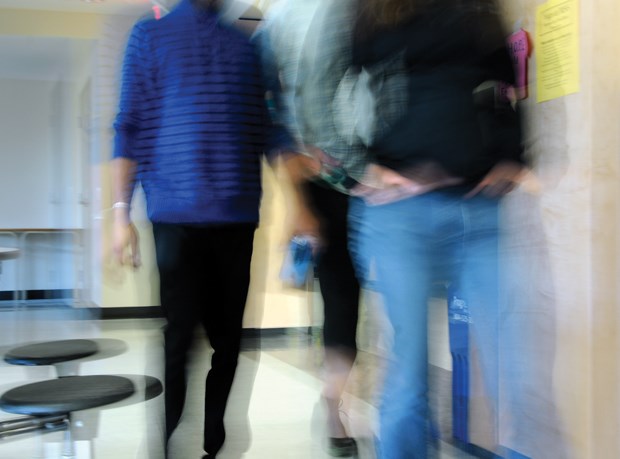There are more teachers, more classes and more portables at North Vancouver schools this year. But that doesn’t mean some teachers aren’t still struggling with heavy workloads, says a representative of the North Vancouver Teachers Association.
“There are far too many classes at the high schools that are in violation of the (teachers contract) language,” Martin Stuible, president of the North Vancouver teachers union told board of education trustees Nov. 21. That means many classes are still too big, or contain more than the agreed-on number of special needs students in classes. Regular classrooms are supposed to have no more than three special needs students, with no more than one of those designated as having more severe challenges.
Yet “there are many classrooms that have four, five and six (special needs students in them),” said Stuible.
Some of the larger class sizes are because of lack of space, said Stuible.
Stuible told trustees he’d like to see portables added to secondary schools to help create more classes. The school district should also speed up the process of building a new elementary school in Lower Lonsdale, to take overcrowding pressure off schools like Ridgeway, he said.
Specialist teachers, in particular - such as school counsellors, psychologists and speech and hearing specialists who don’t work in regular classrooms – are also struggling with their work loads, said Stuible, adding those teachers work with the neediest students. “The number of students they have to serve and deal with is pretty high,” he said.
Chris Atkinson, assistant superintendent, said the North Vancouver school district has met all contract requirements for hiring specialist teachers and is in the process of hiring more. Those positions are sometimes difficult to fill, because of the specialized skills involved – and the fact those teachers are in high demand throughout the province, he said.
Atkinson added decisions about how many classes to add have more to do with funding to hire teachers than it does with space. School districts are provided with a finite amount of money from the province to hire teachers, he said.
In his report to the board, Atkinson said there are 30 more full-time teachers in North Vancouver this year – 910 compared to 880 last year.
But while funding for classroom teachers has increased following the teachers win in court, some other funding not covered by the teachers’ contract has been removed.
Atkinson’s report showed average class sizes in the district are down this year between one and two students per class at most grade levels.
The number of split grade classes has doubled this year as administrators juggle class size and composition requirements – 191 classes combine multiple grades into one class compared to 108 classes last year.
At the high school level, 54 classes have more than 30 students in them this year – half the number of classes with those numbers last year. Handsworth and Seycove schools had the highest number of large classes while Carson Graham had the biggest drop in numbers of large classes.
In cases where the class size or composition rules aren’t being met, teachers have the option of requesting extra help in class or receiving extra preparation time, when substitute teachers are brought in to cover their classes. In October, that added up to 228 person days of extra teaching time, district wide.
West Vancouver teachers are in a very different situation.
Their restored contract from 2002 never contained any class size limits beyond the primary grade level and is also silent on how many special needs students can be integrated into a regular classroom at one time.



